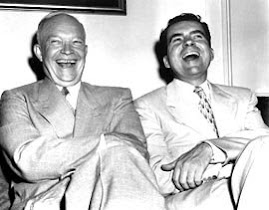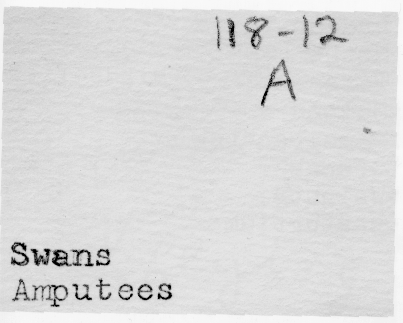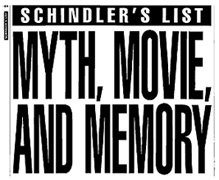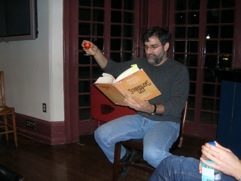 I'm taken by what's been called "pop surrealism." This is recent (post-2000), mostly southern-California and Detroit-area stuff, but its visual basis seems often to combine 1950s-era kitsch advertisement and space-race era forms, modernist design (and coloring), 1960s TV characters, and skeletal or monstrous deformations and grotesques (cute kittens in a basket, but they have three eyes; a monkey with a clown head carrying a trophy and a dented Arthurian sword across a Hudson School landscape).
I'm taken by what's been called "pop surrealism." This is recent (post-2000), mostly southern-California and Detroit-area stuff, but its visual basis seems often to combine 1950s-era kitsch advertisement and space-race era forms, modernist design (and coloring), 1960s TV characters, and skeletal or monstrous deformations and grotesques (cute kittens in a basket, but they have three eyes; a monkey with a clown head carrying a trophy and a dented Arthurian sword across a Hudson School landscape). There's Charles Kraft's carefully made porcelain figure, with hand-painted underglaze: a rabbit with a dagger stuck in its back, 12" tall - called Sal Mineo Bunny (2000).
Larry Reid's essay on pop surrealism says it combines "mid-century dementia" with "bad-ass low brow." He observes about the 1950s what has been said many times before: "Beneath the thin crust of conformity that characterized mid-century America lay a bubbling caldron of weirdness." Well now, in the first decade of the 21st century, mostly young painters have founded an underground art that looks back at the 50s as non-witnesses who see, or try to see, only the surface (and not the psychological or political depth) of that weirdness - who see the 50s through the pop culture of the 60s and don't show any loyalty to the experience of either.
It's a steady diet of drive-in monster movies, Rat Pack playboys, prehistoric fantasy Flinestones immediately following the futurism of the Jetsons, cathode characters, the anti-Comics hysteria, the mayhem of a 1960-era Los Angeles hot-rod emporium - all combined and gone awry.
 Tim Biskup's The Demon Painter (2001 - above) is not actually typical of the group, given what I've said above. Yet then again, it is - in a more specifically painterly way. It nods toward the figure-drawing end of the depictive spectrum modernist Paul Klee painted, pushing it toward cartoonishness, adding a little beatnik straggliness, and creates a dark yet comic vision of the artist's position. I've inserted a few figures
Tim Biskup's The Demon Painter (2001 - above) is not actually typical of the group, given what I've said above. Yet then again, it is - in a more specifically painterly way. It nods toward the figure-drawing end of the depictive spectrum modernist Paul Klee painted, pushing it toward cartoonishness, adding a little beatnik straggliness, and creates a dark yet comic vision of the artist's position. I've inserted a few figures  from Klee here for comparison, "Dancing Girl" and "The Drummer Boy" (both from the
from Klee here for comparison, "Dancing Girl" and "The Drummer Boy" (both from the Chicago Institute).
Isabel Samaras (like Biskup, she's from L.A.) does oil on wood - more straightforward remakings of 60s TV. Batman and Robin sharing a French kiss in Secrets of the Batcave part 2 (2002). A Madonna and Child panel in medieval style - except that they are Hollywood-kitch chimps from Planet of the Apes (Behold My Heart of 2003). Then there's the Botticellian Birth of Ginger of 2002 (below). (It takes off, of course, from the 60s TV show, Gilligan's Island, which is a child, in a way, of the boob-tube version of the Beat revolution, via the Maynard G. Krebs-Gilligan equation.)
Robert Williams, one of the artists included in Pop Surrealism, ed. Kirsten Anderson (Ignition Publishing/Last Gasp, 2004), embraces the category "low brow art," offers topsy-turvey phrases such as "dumbing down to DaVinci," describes his California aesthetic origins in comic book art, carnival-show banners from the 1880s through the 1950s, music posters, hot rod and biker art, pin-up art, graffiti and beach-bum graphics and believes that, visually and more generally culturally speaking, Buster Crabbe as Buck Rogers and John Glenn are the same person.







 "I teach horizontally, meaning that while I might begin with a fixed idea of what I'm going to teach that day, I let it drift rhizomatically way off topic, often pulling it back when it gets too far. I rely on non-fixed materials to teach this way; the whole world is at my fingertips. Should I go off on a tangent about John and Rauschenberg and their love relationship as expressed in Rauschenberg's bed, an image of that bed is always a click away. From there, we can head anywhere into the non-fixed universe, be it film, text or sound. And of course, that always takes us elsewhere. As Cage says, 'We are getting nowhere fast.'"
"I teach horizontally, meaning that while I might begin with a fixed idea of what I'm going to teach that day, I let it drift rhizomatically way off topic, often pulling it back when it gets too far. I rely on non-fixed materials to teach this way; the whole world is at my fingertips. Should I go off on a tangent about John and Rauschenberg and their love relationship as expressed in Rauschenberg's bed, an image of that bed is always a click away. From there, we can head anywhere into the non-fixed universe, be it film, text or sound. And of course, that always takes us elsewhere. As Cage says, 'We are getting nowhere fast.'" 

 that anyone has yet got the imaginative measure of that terrifying day six years ago. Certainly our Tolstoy has not crawled out of the rubble. The closest we have, Don DeLillo, succeeded as an essayist-journalist ("In the Ruins of the Future: Reflections on Terror and Loss in the Shadow of September,” Harper’s, December 2001) but, to my mind, failed as a novelist ("Falling Man"). One reason, perhaps, is that the remembered emotion was instantly buried under a pile of cultural junk.' - Tod Gitlin in his review of Susan Faludi's The Terror Dream (written for
that anyone has yet got the imaginative measure of that terrifying day six years ago. Certainly our Tolstoy has not crawled out of the rubble. The closest we have, Don DeLillo, succeeded as an essayist-journalist ("In the Ruins of the Future: Reflections on Terror and Loss in the Shadow of September,” Harper’s, December 2001) but, to my mind, failed as a novelist ("Falling Man"). One reason, perhaps, is that the remembered emotion was instantly buried under a pile of cultural junk.' - Tod Gitlin in his review of Susan Faludi's The Terror Dream (written for 






























